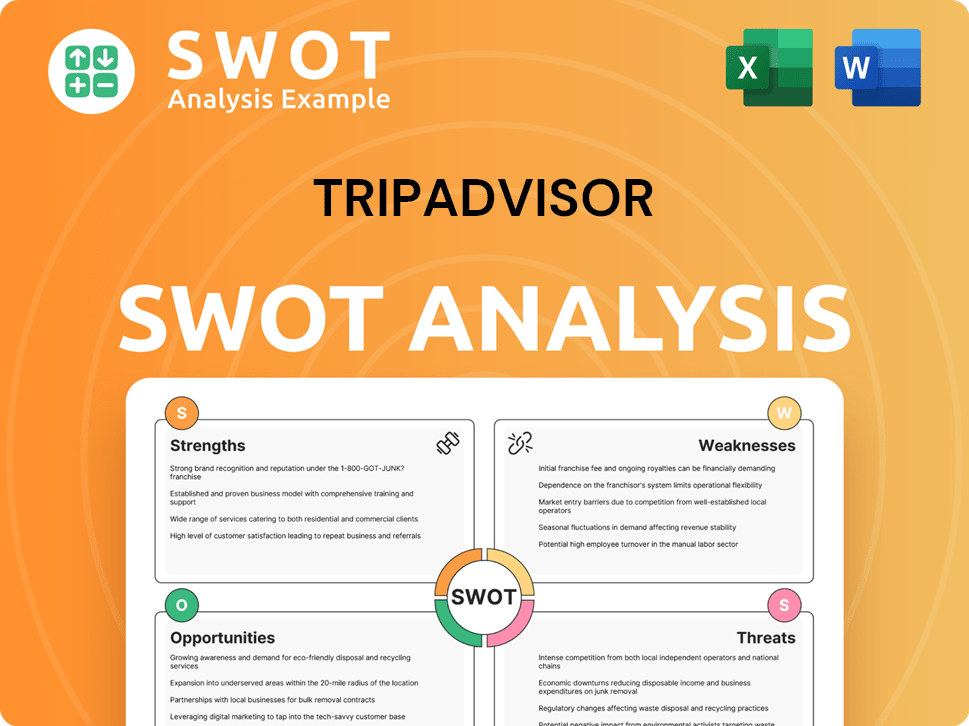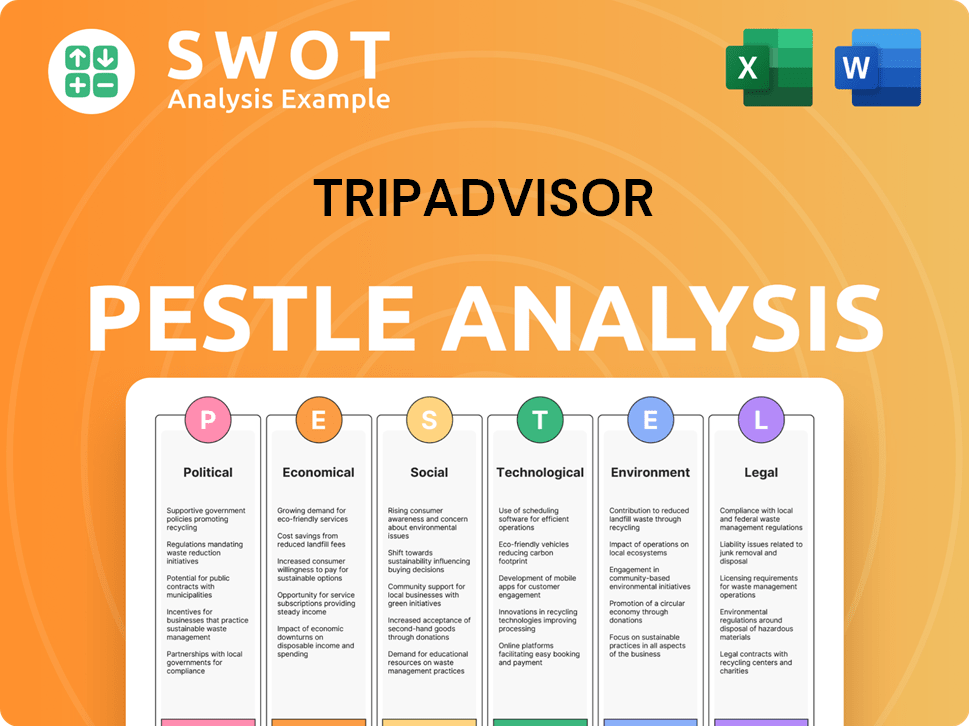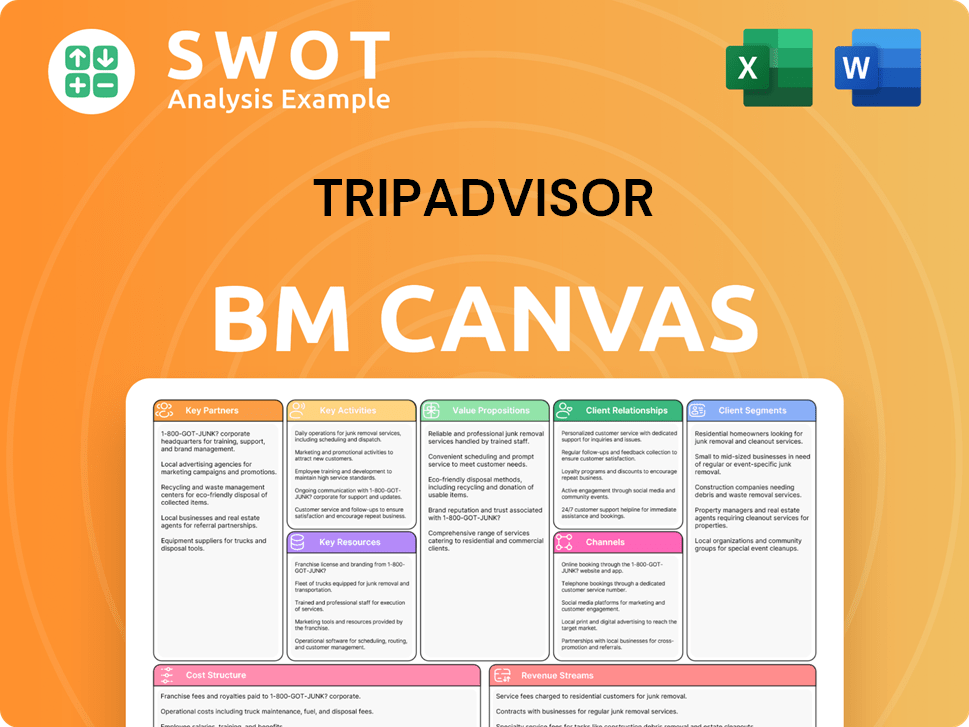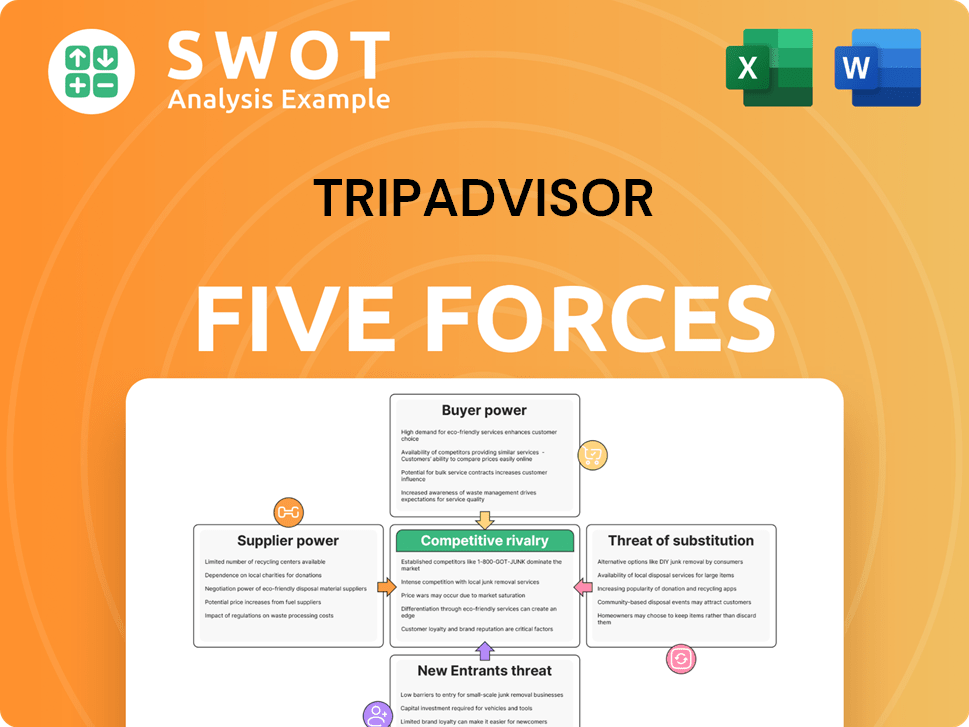TripAdvisor Bundle
Can TripAdvisor Conquer the Ever-Changing Travel Market?
TripAdvisor, a pioneer in online travel, revolutionized how we plan vacations with its user-generated content. From its humble beginnings in 2000, the platform has evolved into a global powerhouse, boasting over a billion reviews and ratings. But how does TripAdvisor maintain its edge in a fiercely competitive industry?

This analysis dives deep into the TripAdvisor SWOT Analysis to dissect the company's position within the dynamic TripAdvisor competitive landscape. We'll explore its main rivals, analyze its market share, and evaluate its strategic responses to industry shifts. Understanding TripAdvisor's competitors and its unique value proposition is key to forecasting its future in the ever-evolving travel industry, and conducting a thorough TripAdvisor market analysis.
Where Does TripAdvisor’ Stand in the Current Market?
TripAdvisor holds a strong position in the travel industry. It serves as a comprehensive platform for users to plan and book travel experiences. In February 2025, the platform saw approximately 120 million visits, highlighting its global reach.
The company's core operations revolve around providing reviews and ratings for hotels, restaurants, and experiences. It also offers booking tools and meta-search capabilities. This allows users to gather information and make reservations efficiently, which is a key part of its value proposition. This is an important aspect when considering the Target Market of TripAdvisor.
TripAdvisor's value proposition lies in its ability to provide a one-stop shop for travel planning. This includes a vast database of user-generated content, which helps travelers make informed decisions. It also offers a wide range of booking options. This makes it a convenient and reliable platform for both planning and booking travel experiences.
TripAdvisor's market share within the reservation and online booking category was 40.92% in 2025. While the Brand Tripadvisor segment saw an 8% decline in revenue in 2024, other segments showed growth.
The United States is the largest market for TripAdvisor, contributing two-thirds of its global revenue in 2024. The United Kingdom is also a significant market. This geographic concentration is a key factor in understanding the company's market position.
The experiences segment, Viator, saw a 14% increase in revenue, reaching $840 million in 2024. TheFork, its dining brand, grew by 18% to $181 million in the same year. As of March 31, 2025, TripAdvisor had approximately $1.2 billion in cash and cash equivalents.
The Brand Tripadvisor segment's revenue declined by 8% in Q1 2025. This indicates a shift in the company's focus. Experiences and dining are increasingly contributing to overall revenue and profit, suggesting a strategic realignment.
The TripAdvisor competitive landscape includes major players in the online travel agencies and travel industry. Understanding TripAdvisor's position requires analyzing its market share, revenue streams, and growth strategies.
- TripAdvisor's main rivals include Booking.com and Expedia.
- Competitive advantages include a vast user-generated content database.
- TripAdvisor's strengths and weaknesses are key for market analysis.
- Analyzing TripAdvisor's business model helps understand its position in the travel market.
TripAdvisor SWOT Analysis
- Complete SWOT Breakdown
- Fully Customizable
- Editable in Excel & Word
- Professional Formatting
- Investor-Ready Format

Who Are the Main Competitors Challenging TripAdvisor?
The online travel industry is fiercely contested, and understanding the TripAdvisor competitive landscape is crucial for anyone involved in the travel sector. The company faces both direct and indirect competition, making TripAdvisor's market analysis a complex task. The competitive environment is constantly evolving, with new players and shifting consumer preferences impacting the dynamics.
TripAdvisor's position in the travel market is influenced by its competitors' strategies and market share. The company's ability to adapt and innovate is critical for maintaining its competitive edge. Analyzing TripAdvisor's business model and understanding its strengths and weaknesses, compared to its rivals, is essential for strategic decision-making.
The competitive landscape includes various online travel agencies (OTAs) and review platforms. These competitors vie for market share and user engagement. The following sections provide a detailed look at TripAdvisor's competitors and the challenges and opportunities they present.
Direct competitors offer similar services and compete on factors like price, features, and quality. These companies directly challenge TripAdvisor's business model.
Booking Holdings, with its flagship brand Booking.com, is a major player. In 2025, Booking.com had over 560 million visits, surpassing TripAdvisor. It offers accommodation, flights, and car rentals, with user reviews.
Expedia Group is another significant OTA, providing hotel bookings, flights, car rentals, and vacation packages. It also features user reviews and recommendations.
Airbnb, known for vacation rentals, has expanded into experiences, tours, and activities. This expansion places it in direct competition with TripAdvisor, particularly in offering local travel recommendations.
Google Travel integrates services like Google Flights and Google Maps, providing personalized recommendations. It competes with TripAdvisor in travel planning.
Indirect competitors offer different services that fulfill the same need or solve the same problem. They compete for user attention and trip planning.
Yelp is a review site for restaurants, hotels, and attractions. Travelers often use Yelp for trip planning, making it an indirect competitor in user-generated content.
These companies compete with Viator, TripAdvisor's experiences brand, in the tours and activities market.
The travel industry is dynamic, with constant shifts in consumer behavior and new entrants. Strategic moves, such as the planned merger between TripAdvisor and Liberty Tripadvisor Holdings, Inc., valued at approximately $435 million, can impact competitive dynamics. For more insights into the company's financial strategies, consider reading about Owners & Shareholders of TripAdvisor.
Understanding the competitive landscape is essential for assessing TripAdvisor's position in the market. The company faces both direct and indirect competition, requiring it to constantly innovate and adapt.
- Booking Holdings and Expedia Group are major direct competitors, offering comprehensive travel services.
- Airbnb challenges TripAdvisor in experiences and local recommendations.
- Google Travel competes in travel planning with personalized recommendations.
- Yelp and other review platforms serve as indirect competitors.
- The market is dynamic, with mergers and evolving consumer preferences impacting the competitive landscape.
TripAdvisor PESTLE Analysis
- Covers All 6 PESTLE Categories
- No Research Needed – Save Hours of Work
- Built by Experts, Trusted by Consultants
- Instant Download, Ready to Use
- 100% Editable, Fully Customizable

What Gives TripAdvisor a Competitive Edge Over Its Rivals?
The competitive landscape for online travel agencies is dynamic, with significant players vying for market share. Understanding the Revenue Streams & Business Model of TripAdvisor is crucial to assessing its position within the travel industry. This analysis focuses on the competitive advantages that help it stand out in a crowded market.
TripAdvisor's success is built on several key strengths, including its extensive user-generated content and strong brand recognition. These factors, combined with continuous innovation, allow it to adapt to changing consumer preferences and maintain a competitive edge. The company's strategic focus on experiences and dining further diversifies its revenue streams and strengthens its market position.
As the travel industry evolves, the company continues to refine its offerings and strategies. This involves leveraging data analytics for personalized recommendations and integrating AI to create seamless discovery and booking experiences. The company's ability to adapt and innovate is critical for long-term success in this competitive environment.
One of the company's primary competitive advantages is its vast repository of user-generated reviews, ratings, and recommendations. By 2024, the platform had surpassed one billion user reviews and ratings, with nearly 80 million contributions in 2024 alone. This extensive content provides valuable insights for travelers. The surge in reviews for experiences, attractions, and activities (up 45% in 2024) further solidifies its position in this growing category.
The company has cultivated a reputation for trust and credibility among its users, which is crucial in the travel planning process. Travelers often rely on these reviews, with 79% reading 6 to 12 reviews before booking a hotel. The company actively combats fraudulent activity, safeguarding travelers from 2.7 million fraudulent reviews in 2024.
Beyond reviews, the platform offers a wide array of tools and resources for travel planning, including booking options for flights, hotels, and activities, itinerary planners, and travel guides. This makes it a 'one-stop shop' for travel needs. This comprehensive approach enhances user experience and drives engagement.
With a presence in over 49 markets worldwide, the company has established itself as a global leader in the online travel industry. This extensive reach allows it to cater to a diverse user base and tap into various travel markets. This global presence is a key factor in its competitive advantage.
The company is committed to innovation, regularly updating its features and services to enhance user experience and stay ahead of competitors. This includes leveraging data analytics and machine learning to provide personalized recommendations and developing an AI-Powered Travel Itinerary Generator. The company is also exploring the intersection of its content with AI agents to create seamless discovery and booking experiences.
- The company is actively managing the threats from increasing competition.
- It is adapting to changing consumer preferences.
- It is addressing the rise of AI-generated content to maintain content integrity.
- The Experiences brand (Viator) and dining brand (TheFork) are central to its strategy.
TripAdvisor Business Model Canvas
- Complete 9-Block Business Model Canvas
- Effortlessly Communicate Your Business Strategy
- Investor-Ready BMC Format
- 100% Editable and Customizable
- Clear and Structured Layout

What Industry Trends Are Reshaping TripAdvisor’s Competitive Landscape?
The TripAdvisor competitive landscape is dynamic, shaped by evolving industry trends and the strategies of both established and emerging players. The travel industry is highly competitive, with significant shifts in consumer behavior and technological advancements influencing market dynamics. Understanding TripAdvisor's position in the travel market requires a deep dive into its strengths, weaknesses, and the strategies it employs to navigate the challenges and capitalize on opportunities.
TripAdvisor competitors include major online travel agencies (OTAs), metasearch engines, and specialized platforms. The company faces risks from changing consumer preferences, the rise of AI-generated content, and economic uncertainties. However, opportunities exist in expanding into new markets, enhancing user experiences, and leveraging data analytics. For a deeper understanding, explore the Growth Strategy of TripAdvisor.
Mobile usage continues to rise, with platforms needing to optimize for mobile experiences. User-generated content remains crucial, but the rise of AI-generated reviews poses a challenge. Personalized recommendations and the growth of experiences are also key drivers.
TripAdvisor faces stiff competition from OTAs and emerging players. Maintaining trust and authenticity in user-generated content is crucial. Regulatory issues and economic uncertainties also pose challenges.
Expanding into new markets and enhancing user experiences present significant opportunities. Leveraging data analytics and strategic partnerships, including AI collaborations, can drive growth. Focus on experiences and dining is also a key area.
TripAdvisor is focusing on operational execution, especially in its Viator and TheFork segments. The company is leveraging its unique assets, investing in AI, and adapting to market demands to drive long-term growth.
The TripAdvisor market analysis reveals a complex environment with both challenges and opportunities. The company's ability to adapt to changing consumer preferences and technological advancements will be critical for its future success. The competitive advantages of TripAdvisor include its vast user-generated content and strong brand recognition.
- TripAdvisor's engagement with AI, like partnerships with Perplexity and OpenAI, aims to improve trip planning and booking.
- The launch of a new membership program in 2025 can support long-term engagement and loyalty.
- TripAdvisor's strategic focus on Viator and TheFork, which are becoming central to the company's strategy.
- The future of TripAdvisor's competitive landscape will be shaped by its ability to innovate and respond to market dynamics.
TripAdvisor Porter's Five Forces Analysis
- Covers All 5 Competitive Forces in Detail
- Structured for Consultants, Students, and Founders
- 100% Editable in Microsoft Word & Excel
- Instant Digital Download – Use Immediately
- Compatible with Mac & PC – Fully Unlocked

Related Blogs
- What are Mission Vision & Core Values of TripAdvisor Company?
- What is Growth Strategy and Future Prospects of TripAdvisor Company?
- How Does TripAdvisor Company Work?
- What is Sales and Marketing Strategy of TripAdvisor Company?
- What is Brief History of TripAdvisor Company?
- Who Owns TripAdvisor Company?
- What is Customer Demographics and Target Market of TripAdvisor Company?
Disclaimer
All information, articles, and product details provided on this website are for general informational and educational purposes only. We do not claim any ownership over, nor do we intend to infringe upon, any trademarks, copyrights, logos, brand names, or other intellectual property mentioned or depicted on this site. Such intellectual property remains the property of its respective owners, and any references here are made solely for identification or informational purposes, without implying any affiliation, endorsement, or partnership.
We make no representations or warranties, express or implied, regarding the accuracy, completeness, or suitability of any content or products presented. Nothing on this website should be construed as legal, tax, investment, financial, medical, or other professional advice. In addition, no part of this site—including articles or product references—constitutes a solicitation, recommendation, endorsement, advertisement, or offer to buy or sell any securities, franchises, or other financial instruments, particularly in jurisdictions where such activity would be unlawful.
All content is of a general nature and may not address the specific circumstances of any individual or entity. It is not a substitute for professional advice or services. Any actions you take based on the information provided here are strictly at your own risk. You accept full responsibility for any decisions or outcomes arising from your use of this website and agree to release us from any liability in connection with your use of, or reliance upon, the content or products found herein.